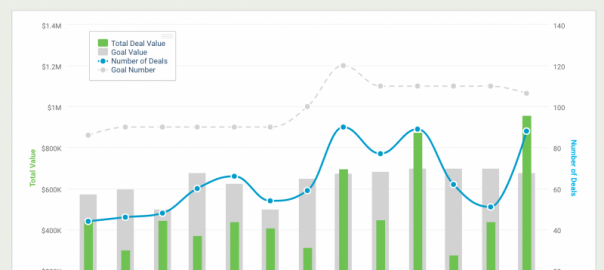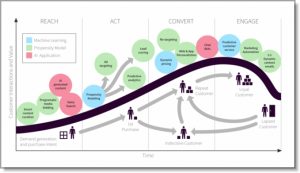New year, new start.
Come January, your sales team will be refreshed, replenished, and ready to hit the new year running. If they had a good 2016, they’ll want to exceed their goal again. If not, they’ll all have something to prove.
But your team shouldn’t charge into the new year all CRMs blazing. Instead, you need to look back to plan ahead. A post-mortem of your team’s past year performance allows you to learn what worked, what didn’t, and how you can use your analytics to make 2017 your best year yet. Here’s why an EOY post-mortem is a good idea and what you need to consider as you run it.
Post-mortems base your yearly strategy in data
In their gut, any sales leader will know whether or not this year was a good one for the team. But moving into 2017 based only on gut feeling can be a disaster for three key reasons:
- You might know your few headline metrics by heart, but not the numbers for the dozen other metrics that you need to work effectively.
- Each of your KPIs is underpinned by a dozen different metrics. Without knowing the underlying causes of your missed goals, you can’t possibly make improvements.
- Your sales and executive teams will be expecting a winning sales strategy for 2017 — they won’t have confidence in your gut feeling.
A post-mortem allows you to back up your instincts with data:
- You can find the exact hits and misses in your main metrics over the past year.
- It allows you to dig deeper into individual metrics and the underlying causes of your missed targets.
- You can then use this information as the basis for your strategy.
Let’s dive deeper into how a post-mortem can help set you up for success in the new year.
Step 1: Figure out what you’ve missed
A post-mortem is about learning. If you missed last year’s targets, you need to learn exactly what and why you missed in order to do better.
A post-mortem isn’t about assigning blame, finding fault, or reviewing individual performance. Instead, it is a critical, constructive discussion about what went right, what went wrong, and what can be done better. The starting point for a successful post-mortem is data.
You need to go through the past year to find where you did and did not hit your goals in your key sales metrics. Bookings will likely be the main metric for a sales team. It is the number you’ve been looking towards for the past year, so you will know whether you hit it or not.
Here is a scenario of a team which didn’t quite hit their goals:

In this case, the team was 78% of their way to the end-year goal at close of business in December.

Ouch. That is going to hurt the sales lead and every single rep. It is understandable that we don’t want to relive the moments we didn’t meet expectations, but it is imperative that you do in order to turn that red to green this time next year.
Probably every single member of this team knew that number already. But it is the data behind that number that really tells the story and allows the team to learn. They didn’t meet a goal number for the entire 12 month period. Though they exceeded their value goal three times, this wasn’t going to be enough given the lack of overall deals.
Additionally, an upward trend in the deal number was curtailed in October and November, meaning that they did a ton of work in December to round out the year — but it was never going to be enough.
The value of post-mortems is understanding how you got to that final number. You can repeat the process with other key metrics:
- Deal size: Did you continually increase your deal size throughout the year?
- Number of opportunities: Did your marketing and SDR teams increase the number of opps for AEs this year?
- Win rates: Did you hit your target win:loss ratio in the past year?
In this scenario, only 18% of opportunities were won:

Again, a nosedive in effectiveness towards the end of fall caused problems for the company.
But even from these high-level metrics, you can start to see a way forward. Keeping deal size and number of opportunities the same, to hit their bookings goal this team would have to increase their win rate by five percentage points to ~23%. This seems a lot, but they weren’t far off this number for the majority of the year.
Suddenly, by braving knowledge and looking at the data, a missed goal is paving the way to a hit goal next year. The next step is to turn these high-level ideas into actionable insights you can use by digging even deeper into your data.
Step 2: Digging deeper into the past year
Your key metrics tell you what went wrong, but they don’t necessarily tell you why — and knowing why is the key to taking learnings from this year into the next.
When you break down the bookings goal by employee, you can see there is marked difference within the sales team:

Andrea and Joe both considerably exceeded their goals in the previous 12 months. But if you look at deal number, it seems through different means. Joe had success with low-number, high-value deals, whereas Andrea had success with high-number, low-value deals.
Again, this isn’t about individual performance or assigning blame. You’re not looking at the bottom of that graph for excuses. You are looking at the high achievers and asking what the team can learn from them.
- What can Robert, Catherine, and John learn from Andrea about closing more deals?
- What can Mary, Darrius and Tess learn from Joe about closing high-value deals?
The same goes for your win ratio. Diving deeper into this single number can tell you a wealth of information that you can carry on into the new year.

This team is losing their opportunities primarily through timing and lost momentum. A sales leader seeing this report will have mixed feelings. On the one hand, they’ll be disappointed they let so many opportunities slip through. They’ll wonder how they are getting the timing of deals so wrong.
On the other hand, this is a blueprint for what needs fixing next year. Get the timing right and momentum going, and that extra 5% of closed-won deals suddenly doesn’t seem too difficult to achieve.
Again, each and every metric can be broken down into its key elements. What works for an EOM post-mortem also works for an EOY post-mortem:
- Review conversion rates: At which stage of your sales funnel are your deals breaking down? Finding the weakest link in this chain can have a massive impact, particularly if it is high up the funnel. A few extra qualified opportunities moving through to an evaluation stage can drastically improve your final conversion rates.
- Compare sales cycles: If a single point in your sales funnel is becoming the rate-limiting step in your sales cycle, finding ways to increase velocity through this step will lead to more deals per year and more revenue. Finding the differences between the cycles of won vs. lost deals can help you work out how to keep momentum up.
Step 3: Set next year’s goals
Now you have all the data needed to set reasonable goals for your team next year. But reasonable doesn’t mean lowering the bar so that you can feel good about hitting similar numbers next December. It means attainable with your team and improvements you want to make.
Improvements to next year’s strategy can come in two ways: coaching and capacity.
Improving your coaching
As a sales leader goes through the data for a post-mortem, lots of questions and ideas should be coming into their head. From the data above, a team lead should be asking themselves:
- What can we do to qualify leads better so that timing and authority are less of an issue? Should SDRs be asking more questions when they reach out to make sure that the contacts can make the decisions within our ideal sales cycle?
- What can we do to keep momentum? Perhaps the sales cadence needs to be reconfigured so that AEs touch base with opportunities more frequently.
Sales leaders shouldn’t see this as only their burden. Ideas should be solicited from all around the company on how to improve each year. Successful reps such as Andrea and Joe should be coaching others and helping the team succeed going forward.
Improving your capacity
Once you have the actual number of what is achievable with your team, you can plan out your bookings goal for the next year. If you know your individual rep quota attainment, conversion rates, and deal size, you can know how many reps and how many opportunities you need to hit different goals. You can then set out your hiring framework to make sure you hit your goal.
You can start towards that goal now by making sure you have enough pipeline for any further hires you make. Though they won’t ramp up immediately, you’ll still need to make sure they have deals to work on in the middle quarters of the new year.

In this case, this company has made a good start. They have enough pipeline coverage for Q1 of 2017. Yes, they still need to get more to make sure they have opportunities throughout the year, but the reps returning in January will have plenty to work with.
Putting it all together
A post-mortem should be collaborative, constructive, and actionable. Each team member should come away from the process knowing exactly what they need to do, clear on how they can achieve their goals, and with renewed vigor in their mission.
Having the right data allows you and your team to achieve this. Instead of presuming you know what went wrong (or right) in the past year, you can ground your advances in facts for the coming year. Allow your team to learn from their failures and successes, and they will always be ready to push past the previous year’s goals and onto new achievements.
Business & Finance Articles on Business 2 Community(88)
Report Post






